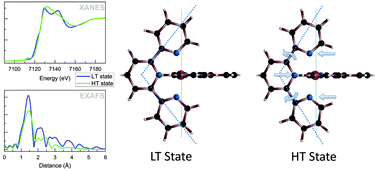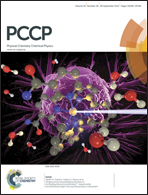Thermally induced structural rearrangement of the Fe(ii) coordination geometry in metallo-supramolecular polyelectrolytes
Abstract
Rigid rod-type metallo-supramolecular coordination polyelectrolytes with Fe(II) centres (Fe-MEPEs) are produced via the self-assembly of the ditopic ligand 1,4-bis(2,2′:6′,2′′-terpyridine-4′-yl)benzene (tpy-ph-tpy) and Fe(II) acetate. Fe-MEPEs exhibit remarkable electrochromic properties; they change colour from blue to transparent when an electric potential is applied. This electrochemical process is generally reversible. The blue colour in the ground state is a result of a metal-to-ligand charge transfer at the Fe(II) centre ion in a quasi-octahedral geometry. When annealed at temperatures above 100 °C, the blue colour turns into green and the formerly reversible electrochromic properties are lost, even after cooling down to room temperature. The thermally induced changes in the Fe(II) coordination sphere are investigated in situ during annealing of a solid Fe-MEPE using X-ray absorption fine structure (XAFS) spectroscopy. The study reveals that the thermally induced transition is not accompanied by a redox process at the Fe(II) centre. From the detailed analysis of the XAFS spectra, the changes are attributed to structural changes in the coordination sphere of the Fe(II) site. In the low temperature state, the Fe(II) ion rests in a quasi-octahedral coordination environment surrounded by six nitrogen atoms of the pyridine rings. The axial Fe–N bond length is 1.94 Å, while the equatorial bond length amounts to 1.98 Å. In the high temperature state, the FeN6-site exhibits a distortion with the axial Fe–N bonds being shortened to 1.88 Å and the equatorial Fe–N bonds being elongated to 2.01 Å.


 Please wait while we load your content...
Please wait while we load your content...